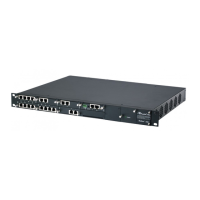Version 6.4 167 March 2012
SIP User's Manual 12. Media
Notes:
• You must either use the ‘DSP Templates page or the
DSPVersionTemplateNumber parameter to select the DSP template, not
both. The DSP Templates page must be used only when two concurrent
DSP templates are required; the DSPVersionTemplateNumber
parameter must be used only when a single template is used.
• If no entries are defined, the device uses the default DSP template (i.e.,
Template 0).
• For supported DSP templates, see 'DSP Templates' on page 835.
• For configuring the Web interface's tables, see 'Working with Tables' on
page 44.
12.8 DSP Channel Resources for Transcoding
In addition to the DSP resources (channels) required for PRI trunk interfaces, the device
provides flexibility in making DSP resources readily available for IP-to-IP functionality. This
is achieved by obtaining DSP resources from the Media Processing Module (MPM) and by
"borrowing" DSP resources from the PRI interfaces (i.e., TRUNKS module).
DSP channels are required for the following:
IP-to-IP application: Each IP-to-IP call session includes two legs, requiring two DSP
resources.
Note: In some scenarios, the IP-to-IP application does not require DSP resources.
To support these capabilities and to allow optimal management of the required DSP
resources, you need to ensure suitable hardware and software configuration, as described
below:
Hardware Configuration: The device can obtain DSP resources using one of the
following hardware configurations:
• Media Processing Module (MPM) Modules: Provide DSP resources for the IP-
to-IP application, and/or IP media for IP media functionality (such as IP-based
conferencing). The device can house up to three MPM modules. The DSP
resources allocation is as follows:
♦ Without Conferencing: When the MPM modules are installed in chassis
slots #3, #4, and #5, the device supports up to 120 DSP resources, where
each module provides up to 40 DSP resources.
♦ With Conferencing: When the MPM modules are installed in chassis slots
#4, #5, and #6, the device supports up to 100 DSP resources (up to 60
conference participants). These channels are allocated as follows:
MPM module in Slot #6 provides 20 channels (and enables
conferencing)
MPM modules in slots #4 and #5 each provide 40 channels (i.e., total of
80 channels)

